“The principal idea is to impart the whole education of the body, mind and soul through
the handicraft that is taught to the children.”
-Mahatma Gandhi, on Crafts-based education
STITCH-ED India collaborated with Diwan Ballubhai School located in Ahmedabad City, for the design workshop with 20 students collectively across 3rd grade to 9th grade. The workshop was organized between the 23rd of December 2019 & 19 February 2020 in two phases; Workshop #1: Hands-on, was centered around thinking through maning, and Workshop #2: Minds-on, focused on children as problem solvers. The school principal and the school arts teacher both offered great support in organizing the workshop.
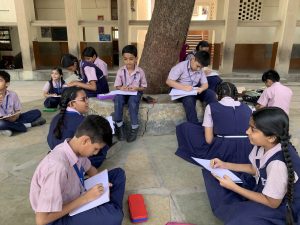
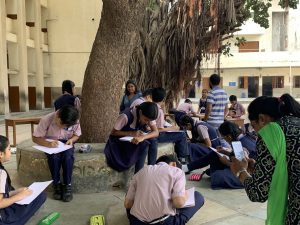
Background
Primary schools in India offer one to two hours of art & craft class every week. The collective understanding of art and craft at primary school largely refers to creating something with your hands, using various craft raw materials, which includes, paint brush, crayons, glue stick, colour pencils, clour paper to name a few. Students are most excited and look forward to these hours as they get to dirty their hands and have fun with colours and materials
At Diwan Ballu Bhai school, the Arts teacher introduces drawing using a formatted drawing text book. With the help of this book, she is able to guide the students through the task on each page. These vary from shading to rendering three dimensional objects to drawing human figures. The structure of this kind of learning follows an outcome oriented approach. Here, students learn by a simple act of mimicking. They try to redraw or copy the reference image provided. Predominantly, the activity involves drawing and colouring. As a general observation, these drawing exercises are independent of the other.The larger objective of the exercise is towards completing the drawing, thereby making it an outcome oriented exercise. The outcome is the same for every student. Taking on from this our primary objective was to break away from a regimented way of learning to an exploratory one thereby making it an open-ended structure.
WORKSHOP#1: Thinking through making
Workshop#1 aimed at introducing a learning experience using familiar materials through an open-ended structure. An open ended approach was designed to be objective driven and not outcome driven.The intent in doing so was to enable making enabled thinking.
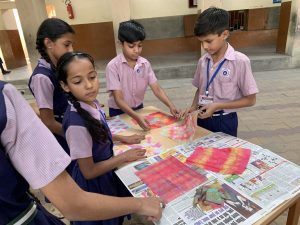

Our approach: Our approach for our first workshop emerged from the thinking of materials most friendly and familiar to school childrens;between clay and paper, the latter was chosen. Also, through paper we intended to engage with larger environmental concerns of use, reuse, recycle besides the functionality and its various utility.
Mixed grouping and outdoor environment: Mixed grouping of only 20 students from 3rd grade to 9th grade were consciously chosen, to create a peer-to- peer interaction and learning environment. An outdoors space was chosen, away from the formal classroom space of benches, tables and black boards.
The workshop was divided into four small segments. 1.Drawing as a warm up exercise. 2 .Exploring relationship between paper folding and patterning. 3.Systematic folding, to introduce origami as a craft. 4. Reflections
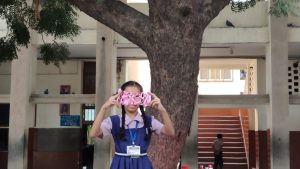

WORKSHOP#2: Children as problem solver
Activity01/04: Drawing and reflection
The students were asked to draw each other on a small piece of paper to loosen up to each other. This exercise works well to lighten the mood and to get everyones participation. This exercise was followed up with spelling out a list of food items that they got to school, starting from home cooked food, to those picked up from the road side shops to packaged food.

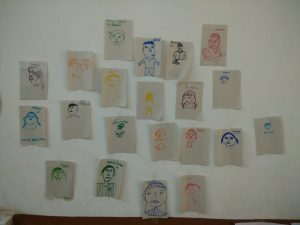

Activity 02/04: Introducing Feel-Imagine-Do-share framework
An inspiring video recorded in River side schools in ahmedabad was shown to children. Children reflected on the process ellaborated in the video and indulged in a group discussion. The purpose of this was to give them the confidence, that by using simple four steps they together can be problem solvers.
Activity 03/04: Introducing single use plastic
Moving on to the chosen theme of our problem area of food packaging, the glimpse on ‘one-time-use’ plastic was introduced through another audio visual titled Plastic Ocean. The impactful visuals of the plastics dumped in the ocean had a starkling impact on the young minds that led them to point out their view on the matter and stories from their immediate surroundings. The following youtube video below shows their views recorded in the class.
Activity 04/04: Design Process in four stages
FEEL: Students were given a simple overview on one-time-use plastic. For this purpose, we had collected discarded potato waffer packaging. Students could relate to this as most would regularly bring a packet or two as part of their daily lunch meal. As a result of this exercise the children were beginning to get more aware of their immediate surroundings and the ill effects caused due to human behaviour to nature of the material.
IMAGINE: Students with the new collective voice and understanding, broke out into smaller groups, to sit and discuss the many possibilities of how all can one address the issues of wafer packaging. For this they sat around a large chart paper and put down the ideas and suggestions made by all.
DO: Combining their concerns with thinking of solutions, the students tried to play around with the materials in ways more than one. ‘What else’ can we do?’ was the key thought behind this exercise. While some recalled some of their craft techniques to either cutting, braid, fold, pleat, cut holes, combine with othe materials etc. This was purely driven by children themself without any faculties intervention. Towards the end, as a souvenir of the workshop, each made a little pocket diary using the packaging waste as a book cover as a gentle reminder to be responsible and to be able to share their experience with others.
SHARE: As a concluding session, the students shared their imagination of how all would tackle this problem from their point of view to each other, which they had put together in the way of posters, little hand crafted articles and small write ups. This workshop was a combination of a mental exercise, where they pondered over the problem both social, environmental, behavioral, collectively and then tried to thing though material itself engaging deeply to even begin questioning regarding the various solutions that one can possible think of from their immediate reach